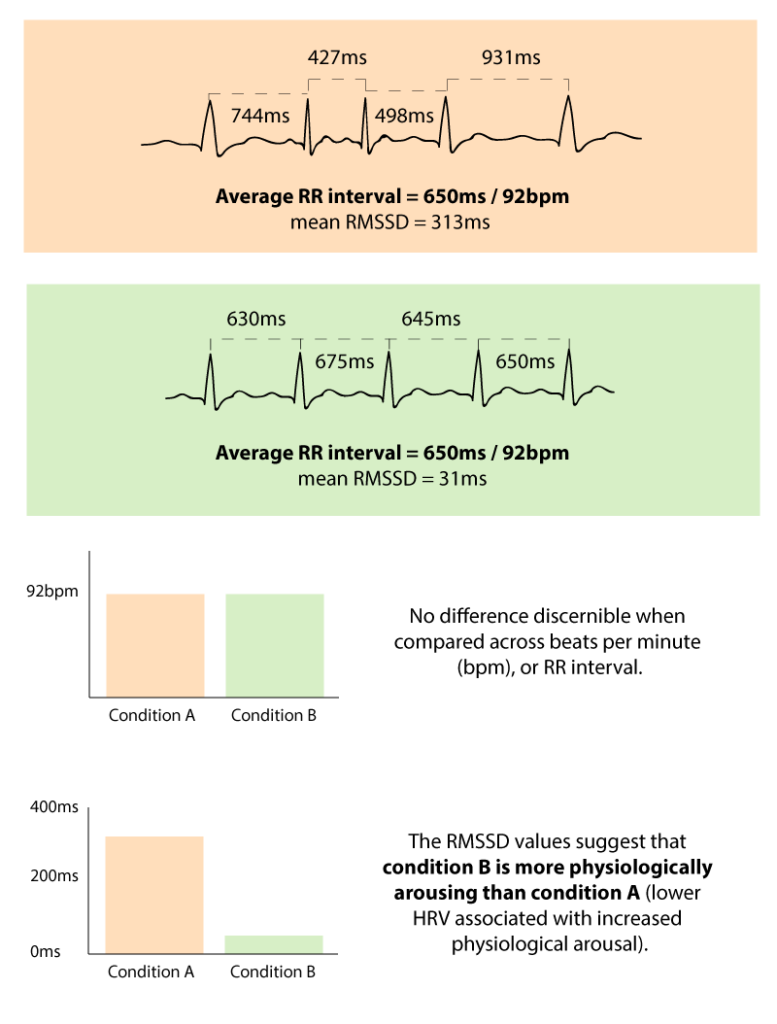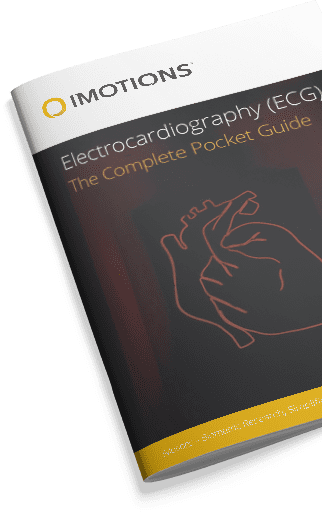Discover how heart rate variability (HRV) from ECG offers a practical, sensitive alternative to EEG for fatigue detection in driving, aviation, and hazardous jobs. Learn about time- and frequency-domain HRV metrics, real-world applications, and their role in understanding stress, mental workload, and recovery in human factors research.
Table of Contents
Fatigue research has life-saving implications in human factors research ranging from drowsiness during driving, wakefulness while flying, and alertness in hazardous occupations.
Electroencephalography (EEG) is considered by many to be the gold standard for measuring fatigue, but comes with many practical challenges to collect useful data during human factors field research as respondents may need to be mobile, and experimental settings may not be optimal for collecting quality EEG data (Pan et al 2021). Blinks, breathing patterns, and analyzing driver’s faces have also been used to detect fatigue during driving as more practical alternatives to EEG.
In this blog, we focus on how heart rate variability metrics from electrocardiography (ECG) can be used to detect fatigue in human factors research. Previously HRV time-domain metrics were available in iMotions ECG module. This year, we launched an ECG R Notebook that enables users to also collect frequency-domain HRV from ECG data.
Using ECG to measure fatigue
Heart rate is the most commonly used cardiac metric in general because it is simple to measure and easy to understand. It is simply the number of heart beats over a chosen interval of time (usually beats per minute, bpm). Generally, heart rate is lower when we are at rest and higher when we are active.
Heart rate can give an indication of fatigue levels. An elevated resting heart rate over time can indicate that your body is under stress or recovering from fatigue. During physical activity, if your heart rate reaches higher than expected levels for a given level of exertion, it may indicate fatigue or overexertion. The speed at which your heart rate returns to baseline after exercise can show your fitness level and recovery state; slower recovery rates may suggest fatigue.
Why use heart rate variability to measure fatigue?
- HRV is a more detailed measure of autonomic nervous system function
- HRV is a more sensitive metric, detecting changes in fatigue that might not be detectable with heart rate.
- HRV can give insights into chronic and acute fatigue.
What is Heart Rate Variability?
Heart rate variability (HRV) reflects the variation in the time between heart beats and is a more detailed measure of the autonomic nervous system compared to heart rate. While a normal resting heart rate may be 60 bpm, this does not mean that heart beats occur precisely one second apart. Some intervals will be a little longer and some will be a little shorter.

HRV metrics summarize these small changes. Increased HRV is a good indication of healthy communication between the brain and heart, reflects how adaptable the autonomic nervous system is to internal and external stimuli, and indicates its ability to return to a resting state (maintain homeostasis). This is why HRV is often used to assess stress.
HRV is a key metric in understanding stress and recovery. Because it reflects the activity of the autonomic nervous system, it is susceptible to input from our mental processes as well as our physical processes. When we are not stressed, the heart has a more variable rate and is more adaptable to our surroundings. When the body is in fight-or-flight mode, HRV tends to be lower.
How to measure heart rate variability?
There are two types of HRV metrics: time-domain metrics and frequency-domain metrics:
Time-domain metrics
HRV time-domain metrics measure the time between heartbeats (interbeat interval, IBI) and quantify the variation. Many metrics use a time-domain approach (see table below for a few examples). They differ in calculation but are all based on different strategies to quantify the variation in IBI.

Frequency-domain metrics
Frequency-domain metrics focus on the regularity of the heart rate by using the R-R interval (also referred to as NN for normal-to-normal with regular heart rhythms). Power spectral densities are made by applying power spectral analyses to parse out frequency information from an ECG (e.g., fast fourier transforms, autoregressive models, or other methods).
In the same way that white light can pass through a prism which sorts wavelengths by size and reveals a rainbow, ECG data can also be sorted into a power spectrum. From this data, we create categories (for colors, we have a range of wavelengths that we call red, different range for yellow, etc). For ECG power spectrums, each wave has a frequency (measured in Hz) so waves can be categorized as high frequency (HF), low frequency (LF) and very-low frequency (VLF).

A commonly used metric for heart rate variability using frequency-domain is the ratio of the power of LF (0.04-0.15 Hz) compared to HF (0.15-0.4 Hz) signals, referred to as LF/HF. The LF/HF ratio represents the balance of the sympathetic and parasympathetic nervous systems, also known as the sympathovagal balance. Generally, LF is said to represent the sympathetic nervous system (SNS) and HF is said to reflect parasympathetic nervous system (PNS) (European Heart Journal, 1996).
Other frequency-domain metrics such as very-low frequency (VLF), ultra-low frequency (ULF), and VHF (very-high frequency) are sometimes reported. Sometimes, these powers are normalized values, and sometimes researchers focus on the frequency of the peaks rather than the power (the area under the curve within the range of the frequency band).
Image indicating power vs peak.
Summary of HRV metrics
| Metric | Clarification | Type |
| RMSSD | Root Mean Square of Successive Differences between heartbeats | Time-domain |
| SDNN | standard deviation of IBIs (Standard Deviation Normal-to-Normal interval) | Time-domain |
| NN50 | Number of successive pairs of NN (R-R) intervals that differ by more than 50 ms | Time-domain |
| pNN50 | proportion of NN50 divided by the total number of NN intervals | Time-domain |
| LF/HF | Low frequency /High frequency | Frequency domain |
There are also non-linear metrics for HRV. For a detailed description of calculations for time-domain metrics, frequency-domain metrics, and non-linear metrics, visit our HRV Blog.
How do you decide which HRV metric to use to detect fatigue?
Because all HRV metrics can be extracted from one ECG signal, researchers often use multiple HRV metrics. Different metrics have different strengths and weaknesses. Some metrics are
more sensitive to changes in the PNS while others are more sensitive to changes in the SNS. Some metrics are better for longer recording periods and others are better for short or ultra-short recordings. For an overview, see Shaffer and Ginsberg 2017. Another reason to prefer a particular HRV metric is that the researchers wish to compare their findings to similar previous studies and thus opt to use similar methods and HRV metrics.
Heart Rate Variability in Human Factors Research
Now that you have had an introduction to what heart rate variability is, why it is relevant for fatigue detection, and the different types of metrics available for HRV, we have summarized three applied research reports that highlight how HRV has been used in human factors research specifically in research with simulators and control panels.

Further Reading:
Patel et al 2011: HRV alone can be used by AI tools to detect drowsiness while driving.
Patel et al 2011: HRV alone can be used by AI tools to detect drowsiness while driving.
This proof-of-concept paper has been cited hundreds of times, both in research and policies (and at least one patent), demonstrating its importance in the field of drowsiness detection in human factors research. Patel et al developed an AI-based system that uses frequency-based HRV to detect fatigue in drivers with 90% accuracy.
Methods
In a previous study with a “continuous and monotonous” driving simulator task, Lal & Craig (2002) had shown that changes in delta and theta activity with EEG can be used to detect fatigue, but did not include their ECG data in the report. Using the ECG data collected from that previous study, Patel et al set out to determine if HRV alone could be used to detect driver fatigue.
Results
Using a power spectral density analysis of ECG data (frequency-domain approach), Patel et al found a prominent peak in the low frequency range in the alert condition and a prominent peak in the high frequency range in the drowsy condition, showing that HRV with frequency-domain metrics could be used to differentiate between alert and drowsy drivers. With just a single layer neural network analysis and a small sample size, researchers were able to accurately detect drowsiness.
These findings demonstrate that HRV frequency-domain metrics alone can be used to detect fatigue during driving tasks, making it a viable alternative to EEG when the conditions are not optimal for EEG.

Further Reading
Majid et al 2016: LF/HF ratio can be used to detect physiological effects in shift work during traffic monitoring while other ECG and EMG metrics could not.
Cited over a hundred times, Majid et al show how using a multimodal approach to fatigue detection can reveal more nuances in our understanding of fatigue. According to the authors, this was one of the first research studies to evaluate the mental workload of operators while they were monitoring traffic congestion.
Monitoring traffic density as a city traffic controller takes long periods of focus on many screens representing hundreds of cameras at intersections. This work varies in intensity, becoming more intense as traffic increases because there is more to do in regulating traffic. It also varies in shifts, because monitoring occurs 24h a day. Participants in this study had a 12h shift, followed by a 24h break, followed by a 12h shift, meaning that they each had one day shift and one night shift.
Methods
For each condition, participants completed the NASA-Task Load Index (TLX), which is a subjective assessment with five, 7-point scales: mental demand, physical demand, temporal demand, performance, effort, and frustration.
ECG and EMG data were collected during rest, low traffic density, high traffic density, and recovery. Majid et al measured muscle tension in the shoulder muscles (upper-trapezius, both sides) using EMG. They also used ECG to measure heart rate and heart rate variability (both time-domain and frequency-domain).
Metrics Overview
| Metric | Tool | Metric Details |
| Shoulder Tension | EMG | Amplitude (µV) |
| Heart Rate | ECG | bpm |
| Heart Rate Variability (Time-Domain) | ECG | SDNN (ms), RMSSD (ms), and pNN50%(see table above for clarification of abbreviations) |
| Heart Rate Variability (Frequency Domain) | ECG | LF/HF |
Results
All metrics showed that the recovery condition is physiologically not the same as the rest. This is an important validation test because the participants were not monitoring traffic (sitting with open eyes in a quiet room for five minutes), but good fatigue detection should be able to differentiate between rest and recovery.
As traffic density increased and monitoring became more complicated, all metrics were affected, showing that there are many ways to capture the physiological effects of cognitive load or work under pressure. Similar to Patel et al, this is a good indicator that ECG and EMG are useful alternatives to EEG for fatigue detection in applied research.
Of all the metrics included in this study, the effect of shift work was only detected with LF/HF ratio (HRV frequency-domain metric). With this HRV metric, researchers could detect shift effects between rest and high traffic density conditions and also between low and high traffic density conditions. This suggests that frequency based HRV can be more sensitive to fatigue in some cases, compared to other metrics, even other HRV metrics. The TLX indicated that participants perceived the workload of the night shift to be higher than the day shift, so having a physiological metric that reflects this subjective experience is an important finding.

Further reading:
Wulvik, Dybvik and Steiner (2019): Comparing self-reports with multi-modal physiological metrics allows complex understanding of fatigue and mental workload.
In this ship bridge simulator study, an iMotions user combined surveys with multimodal physiological methods to investigate how self-reported mental states correlate with physiology.
Methods
In this simulator study, participants (students unfamiliar with ship operation simulators and tasks) steered a 200-m cruise ship in two different scenarios. The open sea scenario included long stretches of time without doing much beyond checking monitoring systems. The harbor scenario was more difficult to steer through, involved additional secondary tasks and had a time constraint.
Subjective and physiological metrics were collected during each scenario. The subjective measurements survey focused on affective states (including arousal, alertness, awakeness, pleasantness, and stress) and workload (with the previously mentioned TLX survey in addition to an overall workload scale). The physiological metrics were EDA (electrodermal activity; also known as GSR, galvanic skin response) and ECG.
Results
This study found that mental workload and stress correlate with both HRV and EDA. The peak HF frequency (a HRV frequency-domain metric reflecting PNS activity) had a strong negative correlation with stress and workload, as well as many EDA metrics. Awakeness correlated with the peak LF frequency (HRV frequency-domain metric reflecting SNS activity).
More complex analyses that can account for multiple variables (principal component analysis, PCA and partial least-squares regression, PLSR) were used to see how combinations of ECG and EDA metrics correlated with the self-reports of affective state and mental workload. These analyses showed that the two scenarios had different physiological and subjective mental state variables as important predictors of variance.
Focusing on the HRV frequency-domain metrics, HF metrics (HF power and HF peak, indicating a role for the PNS) were more associated with the Open Sea scenario and the LF metrics (LF power and LF peak, indicating a role for the SNS) were more closely related to the Harbor scenario, demonstrating that using the HRV frequency-domain metrics separately (rather than as a LF/HF ratio) can also have interesting insights into how the SNS and PNS can function separately. EDA metrics (which reflect changes in the SNS) were also closely related to the Harbour scenario, which further supports this idea of the physiological reaction being more SNS related. Overall, this report shows that HRV frequency-domain metrics are useful metrics for parsing out the different contributions of the SNS and PNS.
An important takeaway from this study is how multimodal research can help accommodate individual variation. In this study, participants were not familiar with the task. Different individuals had different stress levels based on how they react to trying new things and high pressure situations. The self-report surveys will also vary individually as some will tend to differ in how they rate their mental workload and stress. Physiology also differs individually, meaning that it may be hard to detect changes in some individuals or some just have less change than others.
Conclusion
When considering simulations and control panel tasks in which you want to investigate fatigue and metal workload, HRV is worth considering as an alternative to EEG. Although both measure arousal, combining ECG with EDA/GSR can give a more nuanced understanding of how the SNS and PNS are contributing to the physiological response. Finally, exploring mental states with subjective and physiological insights is incredibly powerful, letting us understand what our participants might not be able to put words on.
References
M. Patel, S.K.L. Lal, D. Kavanagh, P. Rossiter, Applying neural network analysis on heart rate variability data to assess driver fatigue, Expert Systems with Applications, Volume 38, Issue 6,2011, Pages 7235-7242, ISSN 0957-4174, https://doi.org/10.1016/j.eswa.2010.12.028.
Majid Fallahi, Majid Motamedzade, Rashid Heidarimoghadam, Ali Reza Soltanian, Shinji Miyake, Effects of mental workload on physiological and subjective responses during traffic density monitoring: A field study, Applied Ergonomics, Volume 52, 2016, Pages 95-103, ISSN 0003-6870, https://doi.org/10.1016/j.apergo.2015.07.009.
Wulvik, A.S., Dybvik, H. & Steinert, M. Investigating the relationship between mental state (workload and affect) and physiology in a control room setting (ship bridge simulator). Cogn Tech Work 22, 95–108 (2020). https://doi.org/10.1007/s10111-019-00553-8
Pan, T., Wang, H., Si, H., Li, Y., & Shang, L. (2021). Identification of Pilots’ Fatigue Status Based on Electrocardiogram Signals. Sensors, 21(9), 3003. https://doi.org/10.3390/s21093003
Free 32-page ECG Guide
For Beginners and Intermediates











